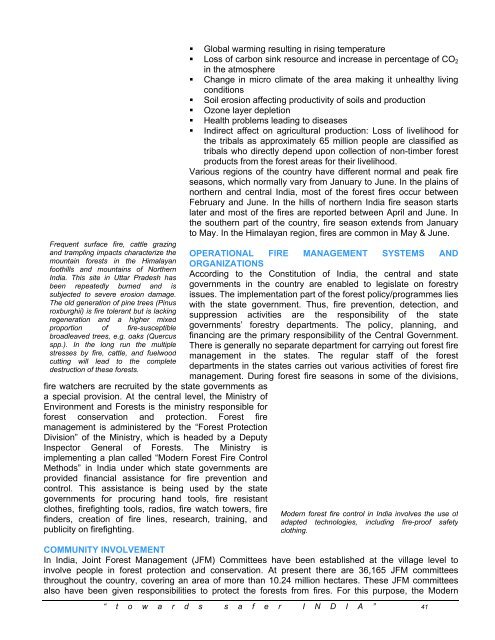Hazards, Disasters And Your Community - United Nations ...
Hazards, Disasters And Your Community - United Nations ...
Hazards, Disasters And Your Community - United Nations ...
You also want an ePaper? Increase the reach of your titles
YUMPU automatically turns print PDFs into web optimized ePapers that Google loves.
Frequent surface fire, cattle grazing<br />
and trampling impacts characterize the<br />
mountain forests in the Himalayan<br />
foothills and mountains of Northern<br />
India. This site in Uttar Pradesh has<br />
been repeatedly burned and is<br />
subjected to severe erosion damage.<br />
The old generation of pine trees (Pinus<br />
roxburghii) is fire tolerant but is lacking<br />
regeneration and a higher mixed<br />
proportion of fire-susceptible<br />
broadleaved trees, e.g. oaks (Quercus<br />
spp.). In the long run the multiple<br />
stresses by fire, cattle, and fuelwood<br />
cutting will lead to the complete<br />
destruction of these forests.<br />
fire watchers are recruited by the state governments as<br />
a special provision. At the central level, the Ministry of<br />
Environment and Forests is the ministry responsible for<br />
forest conservation and protection. Forest fire<br />
management is administered by the “Forest Protection<br />
Division” of the Ministry, which is headed by a Deputy<br />
Inspector General of Forests. The Ministry is<br />
implementing a plan called “Modern Forest Fire Control<br />
Methods” in India under which state governments are<br />
provided financial assistance for fire prevention and<br />
control. This assistance is being used by the state<br />
governments for procuring hand tools, fire resistant<br />
clothes, firefighting tools, radios, fire watch towers, fire<br />
finders, creation of fire lines, research, training, and<br />
publicity on firefighting.<br />
• Global warming resulting in rising temperature<br />
• Loss of carbon sink resource and increase in percentage of CO 2<br />
in the atmosphere<br />
• Change in micro climate of the area making it unhealthy living<br />
conditions<br />
• Soil erosion affecting productivity of soils and production<br />
• Ozone layer depletion<br />
• Health problems leading to diseases<br />
• Indirect affect on agricultural production: Loss of livelihood for<br />
the tribals as approximately 65 million people are classified as<br />
tribals who directly depend upon collection of non-timber forest<br />
products from the forest areas for their livelihood.<br />
Various regions of the country have different normal and peak fire<br />
seasons, which normally vary from January to June. In the plains of<br />
northern and central India, most of the forest fires occur between<br />
February and June. In the hills of northern India fire season starts<br />
later and most of the fires are reported between April and June. In<br />
the southern part of the country, fire season extends from January<br />
to May. In the Himalayan region, fires are common in May & June.<br />
OPERATIONAL FIRE MANAGEMENT SYSTEMS AND<br />
ORGANIZATIONS<br />
According to the Constitution of India, the central and state<br />
governments in the country are enabled to legislate on forestry<br />
issues. The implementation part of the forest policy/programmes lies<br />
with the state government. Thus, fire prevention, detection, and<br />
suppression activities are the responsibility of the state<br />
governments’ forestry departments. The policy, planning, and<br />
financing are the primary responsibility of the Central Government.<br />
There is generally no separate department for carrying out forest fire<br />
management in the states. The regular staff of the forest<br />
departments in the states carries out various activities of forest fire<br />
management. During forest fire seasons in some of the divisions,<br />
Modern forest fire control in India involves the use of<br />
adapted technologies, including fire-proof safety<br />
clothing.<br />
COMMUNITY INVOLVEMENT<br />
In India, Joint Forest Management (JFM) Committees have been established at the village level to<br />
involve people in forest protection and conservation. At present there are 36,165 JFM committees<br />
throughout the country, covering an area of more than 10.24 million hectares. These JFM committees<br />
also have been given responsibilities to protect the forests from fires. For this purpose, the Modern<br />
“ t o w a r d s s a f e r I N D I A ” 41

















